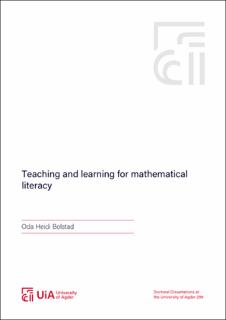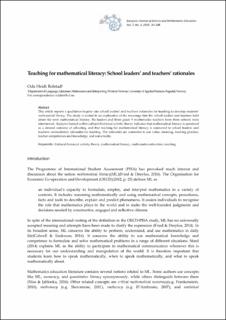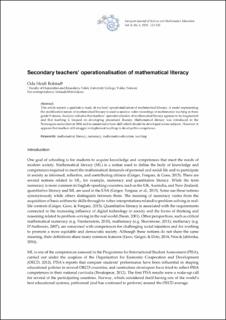| dc.contributor.author | Bolstad, Oda Heidi | |
| dc.date.accessioned | 2020-11-10T21:22:07Z | |
| dc.date.available | 2020-11-10T21:22:07Z | |
| dc.date.created | 2020-11-05T09:26:39Z | |
| dc.date.issued | 2020 | |
| dc.identifier.citation | Bolstad, O. H. (2020). Teaching and learning for mathematical literacy (Doctoral thesis). University of Agder, Kristiansand. | en_US |
| dc.identifier.isbn | 978-82-8427-001-2 | |
| dc.identifier.issn | 1504-9272 | |
| dc.identifier.uri | https://hdl.handle.net/11250/2687234 | |
| dc.description.abstract | This dissertation reports from research that investigates the nature of teaching and learning for mathematical literacy in three lower secondary schools in Norway. Mathematical literacy is a notion used to denote the competences required to meet the mathematical demands of life in modern society. The importance of education for mathematical literacy is emphasised by The Organisation for Economic Cooperation and Development (OECD), and mathematical literacy has become increasingly prominent in national curricula around the world. In the Norwegian curriculum, mathematical literacy is considered a basic skill that should be developed across school subjects.
This study of teaching and learning for mathematical literacy is framed within a cultural-historical perspective on teaching and learning. It draws on cultural-historical activity theory and the theory of objectification. Also, a multifaceted model of mathematical literacy is used to analyse the data. The research uses a cross-sectional case study design involving six school leaders, three mathematics teachers, and their grade 9 students. A qualitative approach to data generation and data analysis was adopted, and the empirical material was generated through interviews and lesson observations.
The results of the study show that teaching and learning for mathematical literacy can be improved. Although the teachers recognise the importance of education for mathematical literacy and ways in which this can be done, they need a strategy for implementing it in their teaching. Also, there is an extensive focus on the contextual element of mathematical literacy. This emphasis may be overshadowing other important elements of mathematical literacy and, in this way, narrowing the meaning of mathematical literacy to only involve the use of mathematics in context. Consequently, opportunities for developing mathematical literacy through, for example, critically evaluating the use of mathematical knowledge and tools are not recognised and pursued. | en_US |
| dc.language.iso | eng | en_US |
| dc.publisher | 07 Media | en_US |
| dc.relation.ispartofseries | Doctoral Dissertations at the University of Agder; no. 299 | |
| dc.relation.haspart | Paper I: Bolstad, O. H. (2019). Teaching for mathematical literacy: School leaders’ and teachers’ rationales. European Journal of Science and Mathematics Education, 7(3), 93-108. http://scimath.net/articles/73/731.pdf. Peblished version. Full-text is available in HVL Open as a separate file: http://hdl.handle.net/11250/2607685. | en_US |
| dc.relation.haspart | Paper II: Bolstad, O. H. (2020). Secondary teachers’ operationalisation of mathematical literacy. European Journal of Science and Mathematics Education, 8(3), 115-135. http://scimath.net/articles/83/832.pdf. Peblished version. Full-text is available in HVL Open as a separate file: . | en_US |
| dc.relation.haspart | Paper III: Bolstad, O. H. (Forthcoming). Lower secondary students’ encounters with mathematical literacy. Nordic Studies in Mathematics Education. Manuscript. Full-text is not available in AURA as a separate file. | en_US |
| dc.title | Teaching and learning for mathematical literacy | en_US |
| dc.type | Doctoral thesis | en_US |
| dc.description.version | publishedVersion | en_US |
| dc.rights.holder | © 2020 Oda Heidi Bolstad | en_US |
| dc.subject.nsi | VDP::Matematikk og Naturvitenskap: 400::Matematikk: 410 | en_US |
| dc.source.pagenumber | 194 | en_US |
| dc.source.issue | 299 | en_US |
| dc.identifier.cristin | 1845112 | |


